Minimizing Soil Nitrogen Leaching by Changing Furrow Irrigation into Sprinkler Fertigation in Potato Fields in the Northwestern China Plain
Abstract
1. Introduction
2. Experiments
2.1. Description of Study Site
2.2. Experimental Design
2.3. Field Management
2.4. Sampling and Analysis on Soil and Crop
2.5. Calculation Method of Nitrogen in Soil
2.6. Data Statistics and Drafting
3. Results
3.1. Changes in Precipitation and Temperature
3.2. Distribution Characteristics of Soil NO3−-N Under Furrow Irrigation and Sprinkler Fertigation
3.3. Changes in Soil NO3−-N Before and After Potato Growth Period
3.4. Cumulative Residual of NO3−-N in the Soil of 40–120 cm after Harvesting Potatoes
3.5. Nitrogen Balance under Furrow and Sprinkler Fertigation
4. Discussion
4.1. Distribution and Cumulative Residual of NO3−-N from Sprinkler Fertigation and Furrow Irrigation
4.2. The Nitrogen Balance under Sprinkler Fertigation and Furrow Irrigation
5. Conclusions
Author Contributions
Funding
Acknowledgments
Conflicts of Interest
References
- Kadyampakeni, D.M.; Morgan, K.T.; Schumann, A.W.; Nkedi-Kizza, P.; Mahmoud, K. Ammonium and nitrate distribution in soil using drip and microsprinkler irrigation for citrus production. Soil Sci. Soc. Am. J. 2014, 78, 645–654. [Google Scholar] [CrossRef]
- Morgan, K.T.; Wheaton, T.A.; Castle, W.S.; Parsons, L.R. Response of young and maturing citrus trees grown on a sandy soil to irrigation scheduling, nitrogen fertilizer rate, and nitrogen application method. Hort. Sci. 2009, 44, 145–150. [Google Scholar] [CrossRef]
- Alva, A.K.; Paramasivam, S.; Sajwan, K.; Ali, F.; Jorge, A.D.; Dirceu Mattos, J. Nitrogen and irrigation management practices to improve nitrogen uptake efficiency and minimize leaching losses. J. Crop Imp. 2006, 15, 369–420. [Google Scholar] [CrossRef]
- Asadi, M.E.; Clemente, R.S.; Gupta, A.D.; Loof, R.; Hansen, G.K. Impacts of fertigation via sprinkler irrigation on nitrate leaching and corn yield in an acid-sulphate soil in Thailand. Agric. Water Manag. 2002, 52, 197–213. [Google Scholar] [CrossRef]
- Di, H.J.; Cameron, K.C. Nitrate leaching in temperate agroecosysterns: Sources, factors and mitigating strategies. Nutr. Cycl. Agroecosyst. 2002, 46, 237–256. [Google Scholar] [CrossRef]
- Mlchabela, M.S.; Madam, A.; Gordon, R.; Burton, D.; Cudmore, D.; Elmi, A.; Hart, W. Gaseous and leaching nitrogen losses from no tillage and conventional tillage systems following surface application of cattle manure. Soil Tillage Res. 2008, 98, 187–199. [Google Scholar] [CrossRef]
- Rajput, T.B.S.; Patcl, N. Water and nitrate movement indrip-irrigated onion under fertigation and irrigation treatments. Agric. Water Manag. 2006, 79, 293–311. [Google Scholar] [CrossRef]
- Ayars, J.E.; Phene, C.J.; Phene, R.C.; Gao, S.D.; Wang, D.; Day, K.R.; Makus, D.J. Determining pomegranate water and nitrogen requirements with drip irrigation. Agric. Water Manag. 2017, 187, 11–23. [Google Scholar] [CrossRef]
- Mosier, A.R.; Bleken, M.A.; Chaiwanakupt, P.; Ellis, E.C.; Freney, J.R.; Howarth, R.B.; Matson, P.A.; Minami, K.; Naylor, R.; Weeks, K.N.; et al. Policy implications of human-accelerated nitrogen cycling. Biogeochemistry 2001, 52, 281–320. [Google Scholar] [CrossRef]
- Adopció de Measures Excepcionals i D’emergència en Relació Amb la Utilització Dels Recursos Hídrics, 2nd ed.; Diari Oficial de la Generalitat de Catalunya: Barcelona, Spain, 2007; pp. 84–86.
- Souza, C.F.; Folegatti, M.V.; Or, D. Distribution and storage characterization of soil solution for drip irrigation. Irrig. Sci. 2009, 27, 277–288. [Google Scholar] [CrossRef]
- Sun, Z.Q.; Kang, Y.H.; Jiang, S.F. Effect of sprinkler and border irrigation on topsoil structure in winter wheat field. Pedosphere 2010, 20, 419–426. [Google Scholar] [CrossRef][Green Version]
- Liu, H.J.; Kang, Y.H.; Yao, S.M.; Sun, Z.Q.; Liu, S.P.; Wang, Q.G. Sprinkler or surface irrigation in the north China plain. Irrig. Drain. 2013, 62, 37–49. [Google Scholar] [CrossRef]
- Lv, G.H.; Kang, Y.H.; Li, L.; Liu, S.P. Nutrient distribution, growth, and water use efficiency in maize following winter wheat irrigated by sprinklers or surface irrigation. Irrig. Drain. 2011, 60, 338–347. [Google Scholar] [CrossRef]
- Pang, X.P.; Leley, J.; Wu, L. Irrigation quantity and uniformity and nitrogen application effects on crop yield and nitrogen leaching. Soil Sci. Soc. Am. J. 1997, 61, 257–261. [Google Scholar] [CrossRef]
- Kagata, H.; Ohgushi, T. Non-additive effects of leaf litter and insect frass mixture on decomposition processes. Ecol. Res. 2012, 27, 69–75. [Google Scholar] [CrossRef]
- Yang, W.Z.; Kang, Y.H.; Feng, Z.W.; Gu, P.; Wen, H.Y.; Liu, L.J.; Jia, Y.Q. Sprinkler irrigation is effective in reducing nitrous oxide emissions from a potato field in an arid region: A two-year field experiment. Atmosphere 2019, 10, 1. [Google Scholar] [CrossRef]
- Yang, W.Z.; Yang, M.D.; Wen, H.Y.; Jiao, Y. Global warming potential of CH4 uptake and N2O emissions in saline–alkaline soils. Atmos. Environ. 2018, 191, 172–180. [Google Scholar] [CrossRef]
- Shi, Z.L.; Li, D.D.; Jing, Q.; Cai, J.; Jiang, D.; Cao, W.X.; Dai, T.B. Effects of nitrogen applications on soil nitrogen balance and nitrogen utilization of winter wheat in a rice-wheat rotation. Field Crop. Res. 2012, 127, 241–247. [Google Scholar] [CrossRef]
- Liu, X.J.; Ju, X.T.; Zhang, F.S.; Pan, J.R.; Christie, P. Nitrogen dynamics and budgets in a winter wheat-maize cropping system in the North China Plain. Field Crop. Res. 2003, 83, 111–124. [Google Scholar] [CrossRef]
- Tilman, D.; Balzer, C.; Hill, J.; Befort, B.L. Global food demand and the sustainable intensification of agriculture. Proc. Natl. Acad. Sci. USA 2011, 108, 20260–20264. [Google Scholar] [CrossRef]
- Burney, J.A.; Davis, S.J.; Lobell, D.B. Greenhouse gas mitigation by agricultural intensification. Proc. Natl. Acad. Sci. USA 2010, 107, 12052–12057. [Google Scholar] [CrossRef]
- Ma, B.; Dwyer, L.; Gregorich, E. Soil nitrogen amendment effets on seasonal nitrogen mineralization and nitrogen cycling in maize production. Agron. J. 1999, 91, 1003–1009. [Google Scholar] [CrossRef]
- Cui, Z.L.; Zhang, F.S.; Chen, X.P.; Dou, Z.X.; Li, J.L. In-season nitrogen management strategy for winter wheat: Maximizing yields, minimizing environmental impact in an over fertilization context. Field Crop. Res. 2010, 116, 140–146. [Google Scholar] [CrossRef]
- Cabrera, M.L.; Kissel, D.E. Evaluation of a method to predict nitrogen mineralized from soil matter under field conditions. Soil Sci. Soc. Am. J. 1988, 57, 1071–1076. [Google Scholar] [CrossRef]
- Perego, A.; Basile, A.; Bonfante, A.; Mascellis, R.D.; Terribile, F.; Brenn, S.; Acutis, M. Nitrate leaching under maize cropping systemsin Pa Valley (Italy). Agric. Ecosyst. Environ. 2012, 147, 57–65. [Google Scholar] [CrossRef]
- Singh, Y.; Rao, S.S.; Regar, P.L. Deficit irrigation and nitrogen effects on seed cotton yield, water productivity and yield response factor in shallow soils of semi-arid environment. Agric. Water Manag. 2010, 97, 965–970. [Google Scholar] [CrossRef]
- Akkal-Corfini, N.; Morvan, T.; Menasseri-Aubry, S.; Bissuel-Bâelaygue, C.; Poulain, D.; Orsini, F.; Leterme, P. Nitrogen mineralization, plant uptake and nitrate leaching following the incorporation of (15N)-labeled cauliflower crop residues (Brassica oleracea) into the soil: A 3-year lysimeter study. Plant Soil 2010, 328, 17–26. [Google Scholar] [CrossRef]
- Bouwmeester, R.J.B.; Vlek, P.L.G.; Stumpe, J.M. Effect of environmental factors on ammonia volatilization from a urea-fertilized soil. Soil Sci. Soc. Am. J. 1985, 49, 297–307. [Google Scholar] [CrossRef]
- Li, Y.; Liu, H.J.; Huang, G.H.; Zhang, R.H.; Yang, H.Y. Nitrate nitrogen accumulation and leaching pattern at a winter wheat: Summer maize cropping field in the North China Plain. Environ. Earth Sci. 2016, 75, 118. [Google Scholar] [CrossRef]
- Qin, Y.L. Water and Fertilizer Use Efficiencies of Potato under Different Fertigation Patterns and Nitrogen Recommendation of Under-Mulch-Drip Irrigated Potato; Inner Mongolia Agricultural University: Huhhot, China, 2013. [Google Scholar]
- Sun, Z.Q.; Kang, Y.H.; Liu, H.J. Soil water distribution characteristics and water balance in winter wheat field under sprinkler irrigation. Agric. Res. Arid Area 2006, 24, 100–107. [Google Scholar]
- Huang, P.; Zhang, J.; Zhu, A.; Li, X.P.; Ma, D.H.; Xin, X.L.; Zhang, C.Z.; Wu, S.J.; Garland, G.M.; Pereira, E.I.P.; et al. Nitrate accumulation and leaching potential reduced by coupled water and nitrogen management in the Huang-Huai-Hai plain. Sci. Total Environ. 2018, 610, 1020–1028. [Google Scholar] [CrossRef]
- Ladha, J.K.; Tirolpadre, A.; Reddy, C.K.; Cassman, K.G.; Verma, S.; Powlson, D.S.; van Kessel, C.; de Richter, B.D.; Richter, D.; Chakraborty, D.; et al. Global nitrogen budgets in cereals: A 50-year assessment for maize, rice, and wheat production systems. Sci. Rep. UK 2016, 6, 19355–19364. [Google Scholar] [CrossRef]
- Vitousek, P.M.; Naylor, R.; Crews, T.; David, M.B.; Drinkwater, L.E.; Holland, E.; Johnes, P.J.; Katzenberger, J.; Martinelli, L.A.; Matson, P.A.; et al. Nutrient imbalances in agricultural development. Science 2009, 324, 1519–1520. [Google Scholar] [CrossRef]
- Sainju, U.M. Improving nitrogen balance with irrigation practice and cropping system. J. Soil Water Conserv. 2019, 74, 622–631. [Google Scholar] [CrossRef]
- Liu, X.J.; Ju, X.T.; Zhang, F.S. Effect of reduced N application on N utilization and balance in winter wheat-summer maize cropping system. Chin. J. Appl. Ecol. 2004, 15, 458–462. [Google Scholar]
- Li, Y. An Investigation of Different Nitrogen Fertilization Levels on Water and Nitrogen Transport, Transformation, and Their Use Efficiency in Winter Wheat-Summer Maize Field; China Agricultural University: Beijing, China, 2015. [Google Scholar]
- Rivett, M.O.; Buss, S.R.; Morgan, P.; Smith, J.W.; Bemment, C.D. Nitrate attenuation in groundwater: A review of biogeochemical controlling processes. Water Res. 2008, 42, 4215–4232. [Google Scholar] [CrossRef]
- Robertson, G.P.; Vitousek, P.M. Nitrogen in agriculture: Balancing the cost of an essential resource. Annu. Rev. Environ. Resour. 2009, 34, 97–125. [Google Scholar] [CrossRef]
- Sebilo, M.; Mayer, B.; Nicolardot, B.; Pinay, G.; Mariotti, A. Long-term fate of nitrate fertilizer in agricultural soils. Proc. Natl. Acad. Sci. USA 2013, 110, 18185–18189. [Google Scholar] [CrossRef]
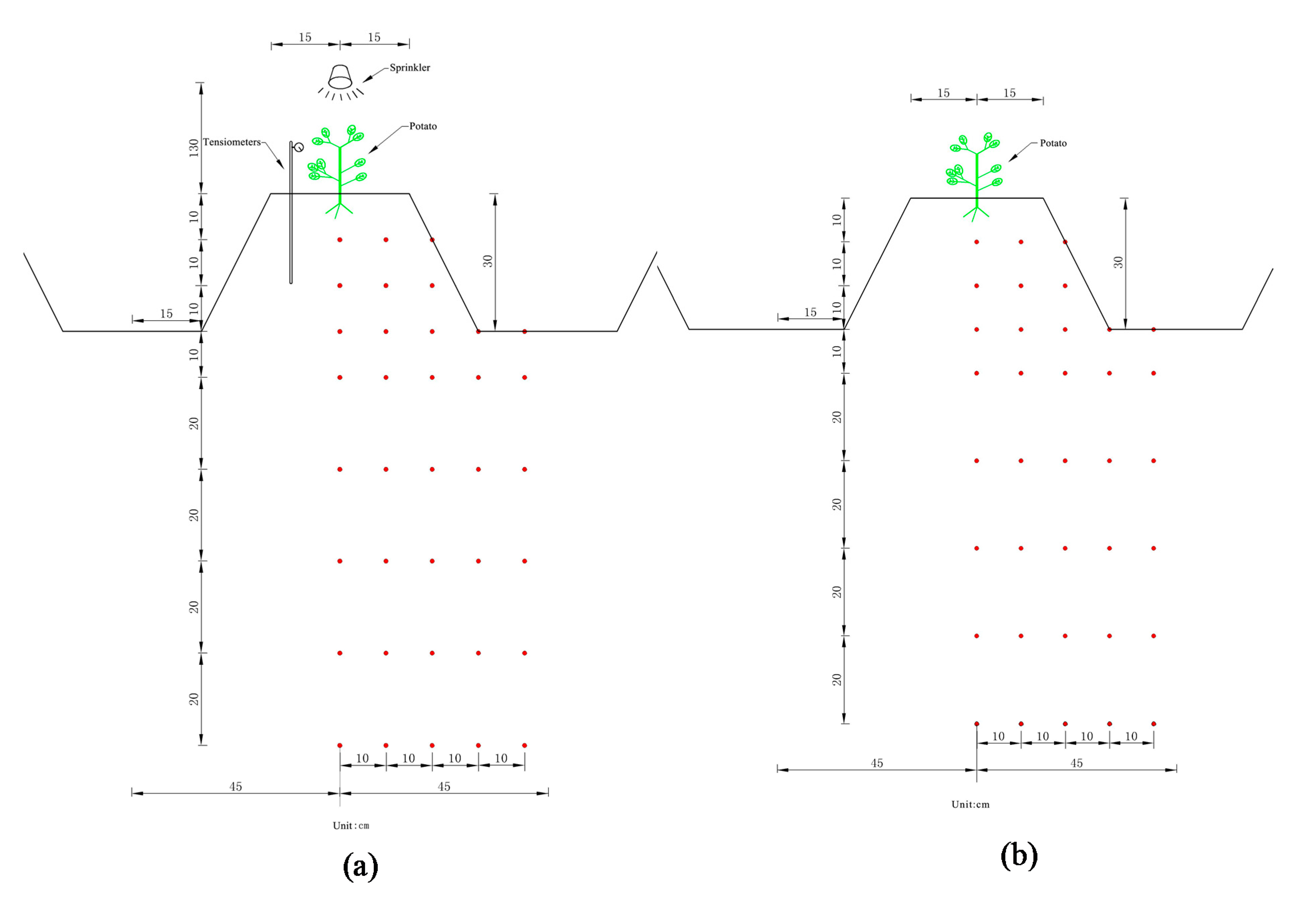
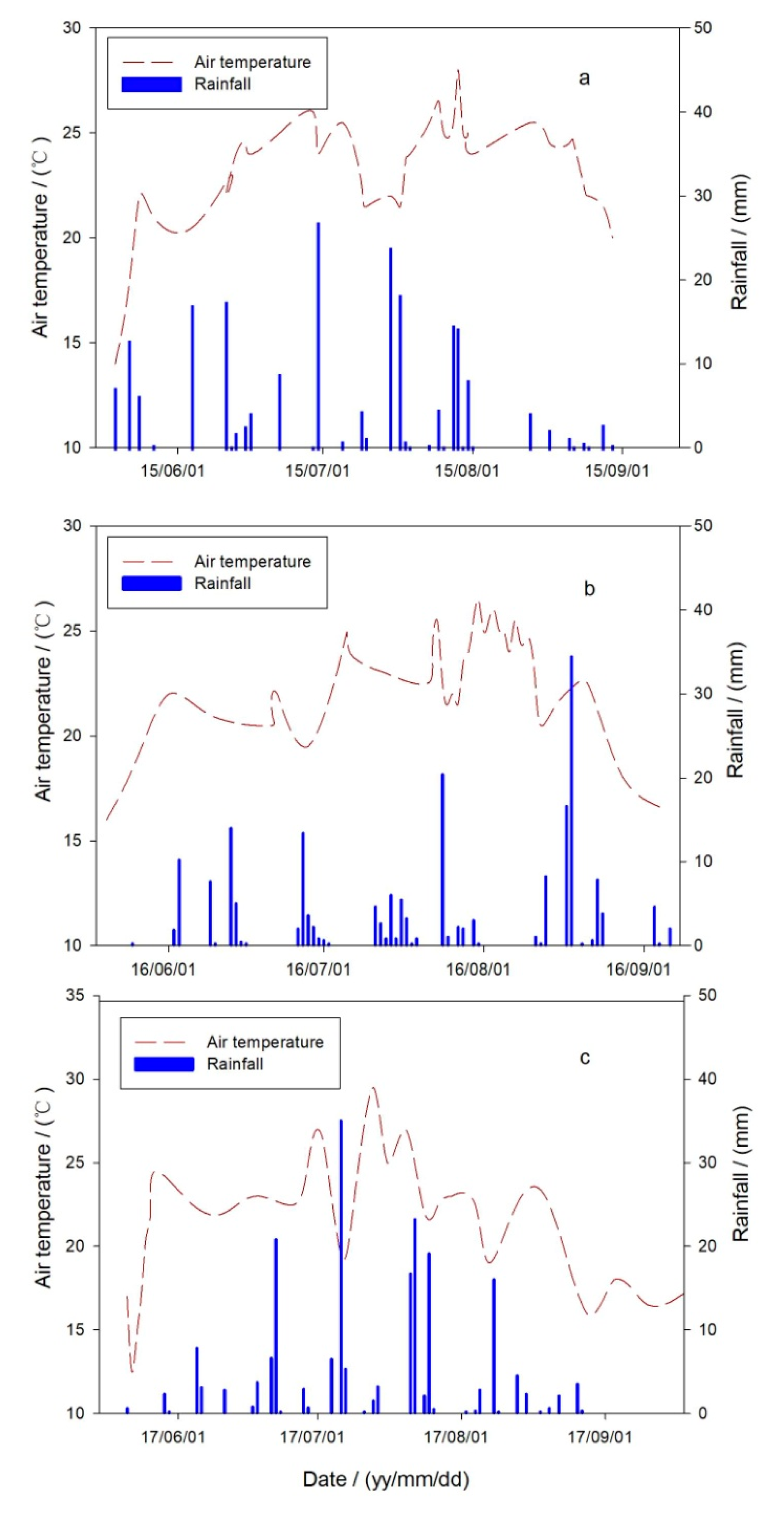

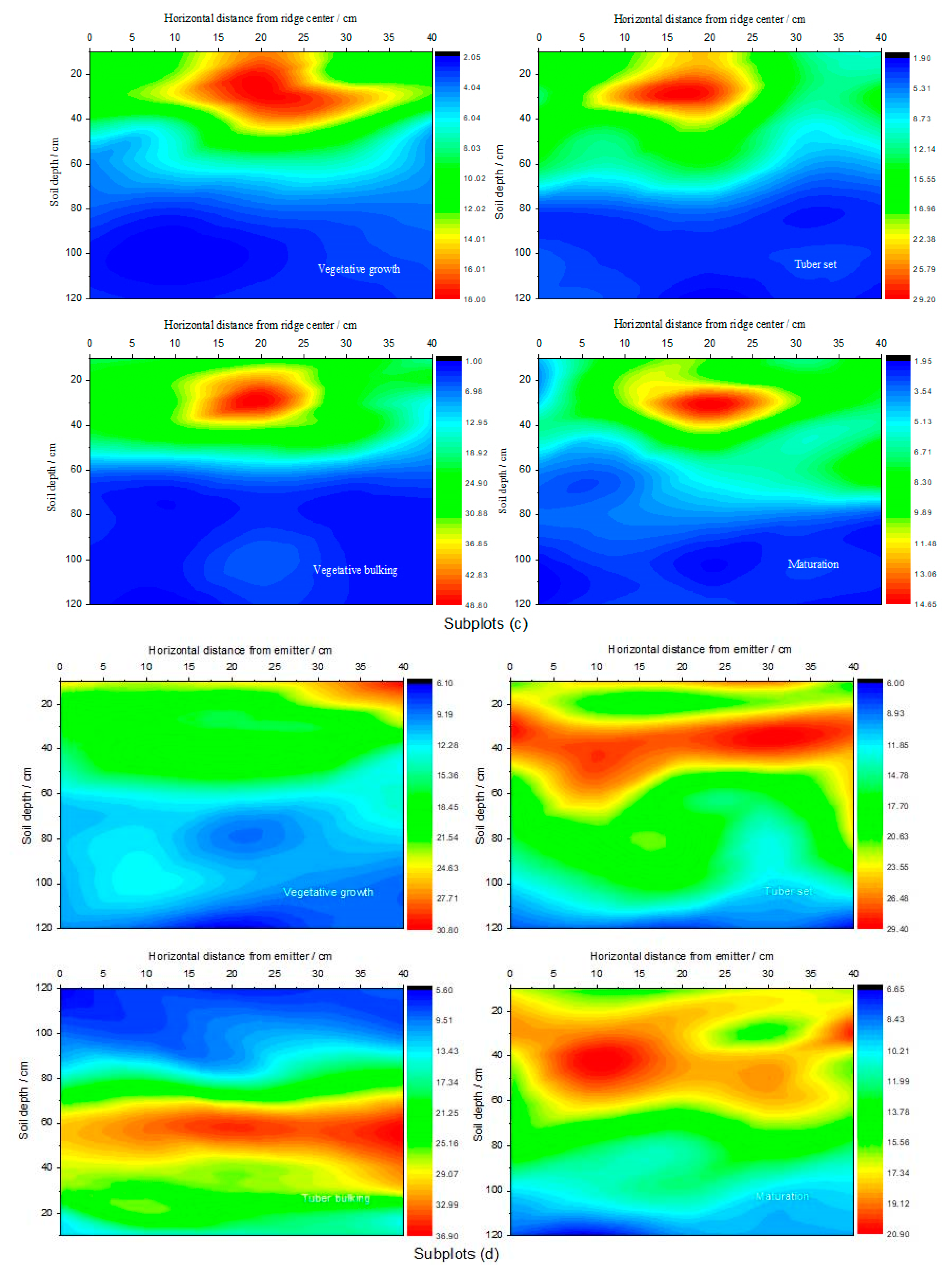
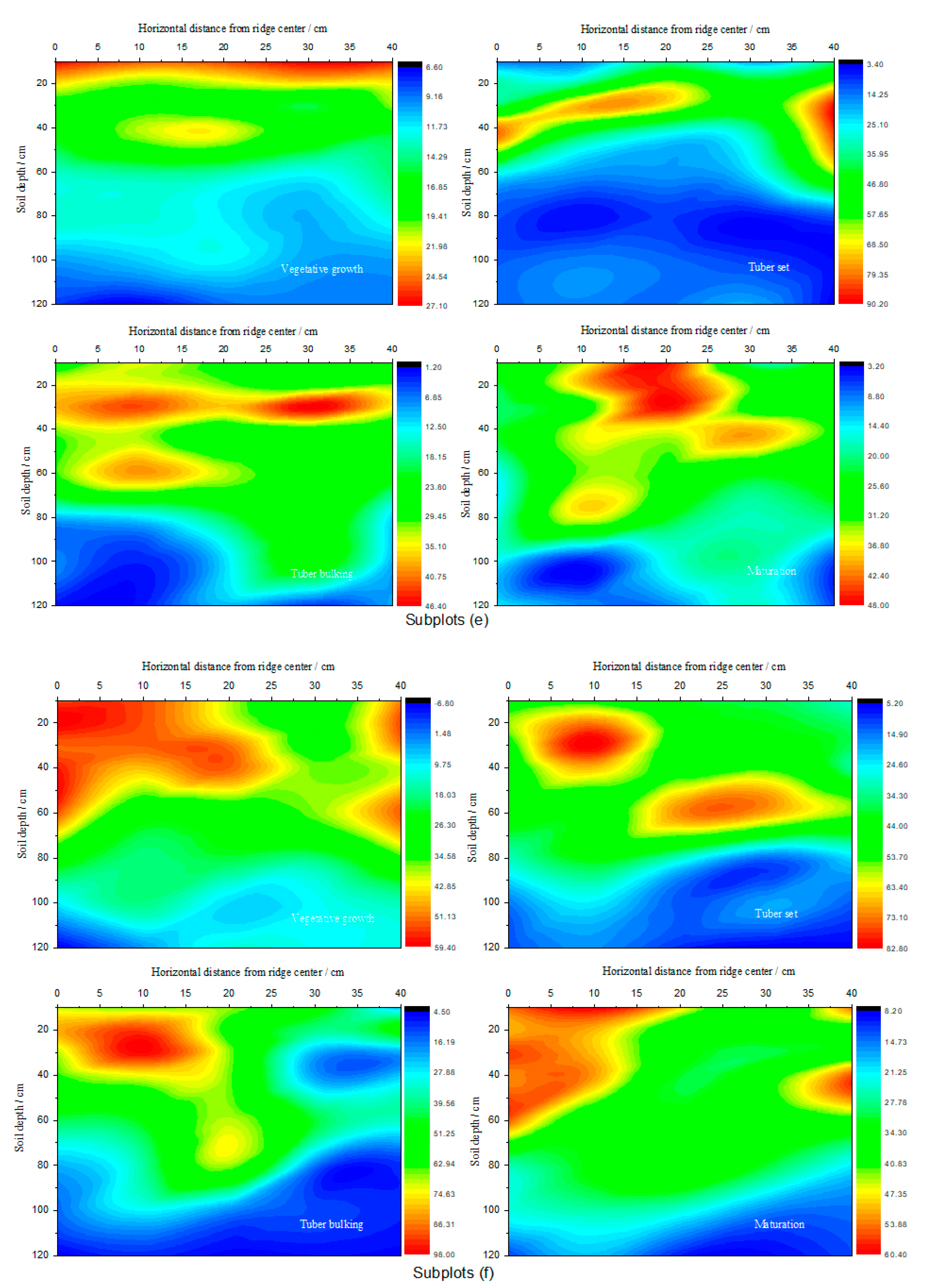

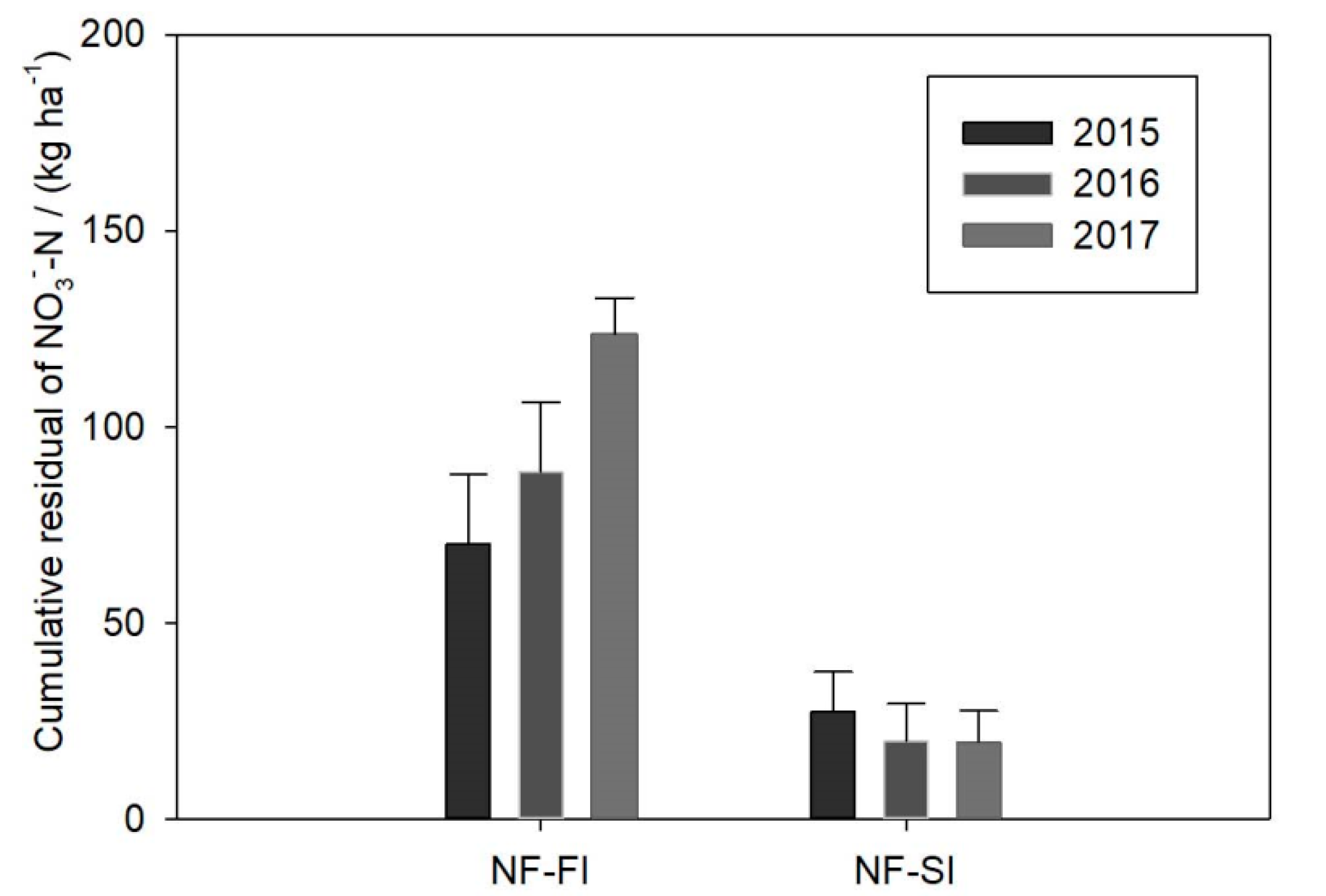

| Time | Treatments | Input/kg∙ha−1 | Output/kg ha−1 | ||||||
|---|---|---|---|---|---|---|---|---|---|
| IN | NF | ANM | NR | NI | NRS(0–40 cm) | NA | ANL | ||
| 2015 | SF | 76.0 | 273.0 | 341.7a | 12.3 | 2.6a | 55.0a | 488.1a | 161.9a |
| FF | 76.0 | 273.0 | 164.1b | 12.3 | 8.2b | 100.3b | 198.0b | 234.7b | |
| 2016 | SF | 70.6a | 273.0 | 167.6a | 11.6 | 2.6a | 48.4a | 345.0a | 132.1a |
| FF | 170.5b | 273.0 | 112.1b | 11.6 | 8.1b | 176.0b | 162.0b | 237.5b | |
| 2017 | SF | 78.3a | 273.0 | 75.5a | 11.7 | 2.7a | 46.2a | 246.0a | 148.9a |
| FF | 264.5b | 273.0 | 60.2a | 11.7 | 8.6b | 215.2b | 126.0b | 276.7b | |
© 2020 by the authors. Licensee MDPI, Basel, Switzerland. This article is an open access article distributed under the terms and conditions of the Creative Commons Attribution (CC BY) license (http://creativecommons.org/licenses/by/4.0/).
Share and Cite
Yang, W.; Jiao, Y.; Yang, M.; Wen, H.; Gu, P.; Yang, J.; Liu, L.; Yu, J. Minimizing Soil Nitrogen Leaching by Changing Furrow Irrigation into Sprinkler Fertigation in Potato Fields in the Northwestern China Plain. Water 2020, 12, 2229. https://doi.org/10.3390/w12082229
Yang W, Jiao Y, Yang M, Wen H, Gu P, Yang J, Liu L, Yu J. Minimizing Soil Nitrogen Leaching by Changing Furrow Irrigation into Sprinkler Fertigation in Potato Fields in the Northwestern China Plain. Water. 2020; 12(8):2229. https://doi.org/10.3390/w12082229
Chicago/Turabian StyleYang, Wenzhu, Yan Jiao, Mingde Yang, Huiyang Wen, Peng Gu, Jie Yang, Lijia Liu, and Junxia Yu. 2020. "Minimizing Soil Nitrogen Leaching by Changing Furrow Irrigation into Sprinkler Fertigation in Potato Fields in the Northwestern China Plain" Water 12, no. 8: 2229. https://doi.org/10.3390/w12082229
APA StyleYang, W., Jiao, Y., Yang, M., Wen, H., Gu, P., Yang, J., Liu, L., & Yu, J. (2020). Minimizing Soil Nitrogen Leaching by Changing Furrow Irrigation into Sprinkler Fertigation in Potato Fields in the Northwestern China Plain. Water, 12(8), 2229. https://doi.org/10.3390/w12082229





